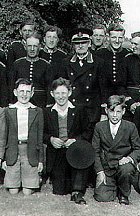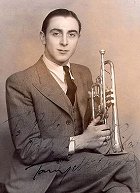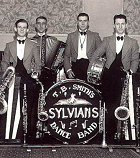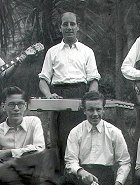MANY an
Ayrshire town can claim an impressive musical pedigree. But surely none
can equal Maybole when it comes to the amount of musical talent per head
of the population. Read about them below and link on the images for links
to other pages on this site. This story appeared in the Ayrshire Post in
March 2002.
|
 |
The capital of Carrick
has proved itself a musical centre of excellence for more than a century.
But things didn't look good back in 1867, when town bandsmen had their
instruments taken away from them - for failing to attend rehearsals! The
instruments were given to the local Volunteers, and although this was
nominally a military band, it was still considered the town band. The
instruments were returned to Maybole Burgh Council around 1900, and
Maybole Burgh Band came into existence. Under professional conductor Mr W.
Shaw, the band won many competitions, and was a popular attraction at town
and district events. Maybole Burgh Band hit another low point in the
1950s, although conversely, a number of dance bands in the town were doing
very nicely by now. The burgh band instruments were said to be
deteriorating in storage, and Maybole Town Council sold them. By
coincidence, the council bought scarlet and ermine robes for the Provost
and Bailies about the same time. And it was a joke in town that the band
had been robbed for robes! |
|
 |
MAYBOLE folk would turn
up their radios for trumpet solos by local legend Tommy McQuater. Born in
1914, Tommy received some brass band tuition, but was largely self-taught.
He began playing professionally with Louis Freeman, whose band performed
on Transatlantic liners. Tommy next worked with bandleaders Jack Payne
(1934) and Lew Stone (1934-35) before joining Bert Ambrose (1936-38).
During and after the war he played with the famous RAF band, the
Squadronaires. Tommy was a regular on radio and TV after the war, first as
a member of Cyril Stapleton's BBC Showband, then as a staff musician under
Jack Parnell. He worked as a freelance player right into the 1980s, and
still lives in London. |
|
 |
SHEONA White began
blowing her tenor horn at the age of 10. The former Carrick Academy pupil
won the BBC Radio 2 Young Musician of the Year title in 1996. She went on
to play with superstars of pop, in the BBC promo version of Lou Reed's
`Perfect Day' which topped the charts and became a platinum disc. Sheona
studied at Salford Unversity between 1992 and 1996, and toured Ecuador and
Brazil as principal horn of the university band. She has been principal
horn for the past five years with the Yorkshire Building Society Band,
winners of the All-England Masters and European championships. Her
professional appointments now include the post of tenor horn tutor at the
University of Salford. |
|
 |
A MAYBOLE band of
around 1920 showed the kind of instrumental line-up at social functions
since the 1890s. It consisted of two violinists, plus flute, cornet and
piano, and this type of band would have played at some great dance nights
in the town hall. Organisations such as the Yeomanry, the Masons, the
bowlers and the quoiters all organised an annual ball. And in days before
the First World War, the youth of the town would take their place in the
Grand March, which always opened a ball. There were several dance classes
in the town, and it was necessary to learn the steps for the Lancers, the
Petronella, the Waltz Cotillion and other favourites. Those were the days
of dancing pumps and white gloves for the gentlemen and long, graceful
frocks for the ladies. |
 |
AMERICAN influences saw
the saxophone become a dominant instrument in the 1930s and 40s. The `sax'
had been around for decades, but found an important niche in jazz and
swing music. A famed Maybole band of the era was Paterson's Ragtime Band,
who played at big functions at Turnberry Hotel. The accordion became a
favourite instrument too, being more portable than a piano! Saxophones
were favoured by T.B. Smith's Sylvians. They even featured as little
motifs on the big drum. The Sylvians were a popular band of the 1930s and
40s. Musicians in a picture loaned to the Post are Jim McCulloch, Jimmy
Colquhoun, Alex MacKay, Borthwick Smith, Robert Hempkin and Jim McDonald. |
 |
HAWAII is a long way
from Maybole, but Jimmy McCulloch fell in love with the sound of the
Hawaiian guitar. And he went on to become one of Britain's top exponents
of the instrument. Jimmy was heard regularly on radio, playing with Felix
Mendelssohn's Hawaiian Serenaders. He was also an accomplished dance band
guitarist, but an arthritic condition prevented him continuing his
career. Back in Maybole, Jimmy showed a whole new generation of keen young
rock `n' rollers how to get to grips with the guitar. And his instruction
stood many in good stead, as he insisted they learn the correct way -
reading `the dots'. Sadly, Jimmy is no longer with us, but his legacy
lives on in many local guitarists. Another evocative picture loaned to the
Post shows Jimmy with a group of local musicians at Culzean Castle in the
early 1950s. The others are: Bobby Law and Len Girvan, with guitars;
Andrew Gardiner, John Hempkin and Albert Holmes. |
|